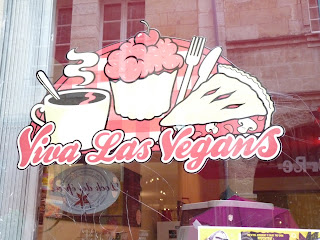
(Image of a "oxo-biodegradable" plastic bag from PG.com--International Packaging)
More and more, the use of plastic bags at grocery and retail stores are being questioned. As I have experienced in France--you have to either bring your bag or buy one at the store. In the United States, the state of Oregon is examining a law that will eliminate single-use plastic bags. (Read more here)
One of my friends lent me a plastic bag full of CDs. Yet instead of being mesmerized by the CDs, I found myself playing with a purple plastic bag from Etam--as I found an interesting message in the bottom of the bag:
This sac is oxo-biodegradable. It has a limited life because, after fragmentation, it becomes biodegradable. Its elimination mode preserves the environment.
Using words like "mode d'élimination" made the bag seem like a prop from a sci-fi novel, so I decided to read what oxo-biodegradable actually means. As many people know, plastic itself is very durable and takes at least 3 to 6 decades to decompose (other studies show up to a thousand years--but since plastic bags have only been around for 50 years, let's not get ahead of ourselves). This is why research has gone into trying to speed up biodegradation in plastic. Oxo-biodegradable bags contain metal salts that speed up biodegradation by breaking down molecular chains in the polymer (compound of large molecules made up of repeated, linked monomers). At the end of the plastic bag's use, it begins to fragment. Once this process begins, the bag is consumed by bacteria and fungi--as the added chemical allows the molecular weight of the bag to be accessible to micro-organisms. The biodegradation process continues until all that is left of the plastic bag is: CO2, water, and humus--not leaving behind petro-polymers that damage the environment. This process, unlike many other "sustainable" projects, will not cost much--as these bags can be made using the same machines as normal plastic bags and the added chemical only accounts for 3% of the bag. (Oxo-Biodegradable Plastics Association)
There are strong arguments for and against the use of these plastic bags: for one, using these bags will maintain current jobs and lives that depend upon the plastic industry--and will abandon some of the unsustainable practices they once held. On the other hand, a large part of our environmental crisis is our overproduction and over-consumption--the exploitation of our resources; rather than making our plastic bags less harmful, we should simply stop making them altogether. Another argument against the use of oxo-biodegradable plastic bags is that they are advertised with a misleading message. My response to this claim is that with any new technology, one must understand what it is and how it works before he or she uses it.
Whatever the better answer is, one thing is certain: there are so many innovative projects and ideas to be realized that will help us better live in the world. It is our responsibility to continue to educate and challenge ourselves on these matters.


